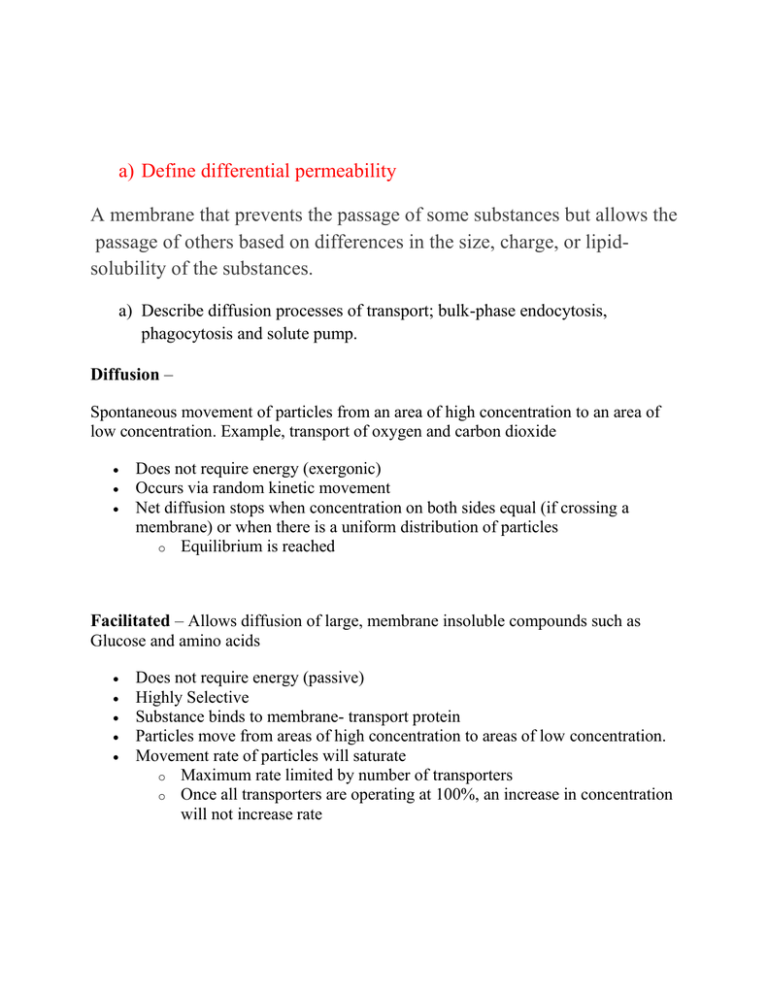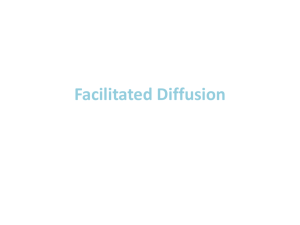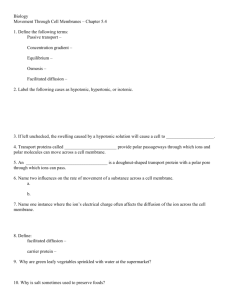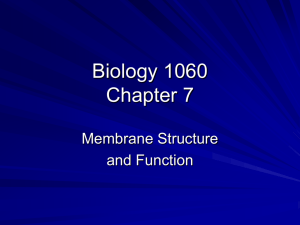Practical-1
advertisement

a) Define differential permeability A membrane that prevents the passage of some substances but allows the passage of others based on differences in the size, charge, or lipidsolubility of the substances. a) Describe diffusion processes of transport; bulk-phase endocytosis, phagocytosis and solute pump. Diffusion – Spontaneous movement of particles from an area of high concentration to an area of low concentration. Example, transport of oxygen and carbon dioxide Does not require energy (exergonic) Occurs via random kinetic movement Net diffusion stops when concentration on both sides equal (if crossing a membrane) or when there is a uniform distribution of particles o Equilibrium is reached Facilitated – Allows diffusion of large, membrane insoluble compounds such as Glucose and amino acids Does not require energy (passive) Highly Selective Substance binds to membrane- transport protein Particles move from areas of high concentration to areas of low concentration. Movement rate of particles will saturate o Maximum rate limited by number of transporters o Once all transporters are operating at 100%, an increase in concentration will not increase rate o Osmosis – movement of water across the membrane Water moves from solution with lower concentration of osmotically active solutes (i.e. the concentration of water is high) to solution with higher concentration of osmotically active solutes (i.e. the concentration of water is low) Water moves from dilute solution to concentrated solution Active Transport Movement across membrane with an energy cost (usually against concentration or electrochemical gradient, but not always) Used to pump specific compounds in or out of the cell Requires energy to overcome the concentration and electrochemical gradient or to allow a large or charged particle to cross membrane Requires specific integral membrane proteins The K+ / Na+ Pump: An Example of Active Transport Cellular [K+] is low and [Na+] is high - must pump K+ in and pump Na+ out K+ and Na+ transport require ATP energy a) Describe the processes that account for the movement of substances across the plasma membrane and to indicate the driving force for each. Facilitated diffusion utilizes carrier proteins that participate in the movement of the substance across the membrane. An interaction of the membrane proteins with the diffusing substance causes the membrane proteins to transport the substance across the membrane. • Facilitated diffusion typically involves the diffusion of large molecules, such as the facilitated diffusion of glucose into the cell. b) Determine which way substances will move passively through a differentially permeable membrane (given the appropriate information on concentration Diffusion is a process of equalization which involves movement from an area of high concentration to an area of low concentration (along a concentration gradient).Concentration differences) Forces of Fluid Movement • Two driving forces for movement of water between the blood plasma and interstitial fluid are: – hydrostatic pressure (blood pressure) and – osmosis. Hydrostatic Pressure – Hydrostatic pressure influences fluid movement from the capillary into the interstices and fluid movement from the interstices into the capillary. • Osmotic pressure – Osmotic pressure influences fluid movement from the capillary into the interstices and fluid movement from the interstices into the capillary.







